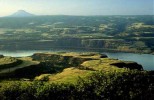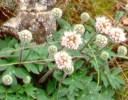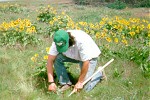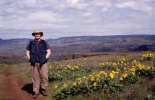Success stories: Tales of improving our native biodiversity
Mandy Tu/GIST
January 2001
Photographs
Click
on the images below to view photographs related
to this success story.

|

|

|

|
The Setting
The Tom McCall Preserve sits high on the edge of the Columbia River Gorge,
in north central Oregon. The Gorge lies in the transition zone between the
moist, heavily forested west side of the Cascade Mountains and the drier
bunchgrass prairie of the Columbia Plateau. Situated along this interface,
the preserve supports many different vegetation types and wildlife habitats
on its 213 acres. Biodiversity is high: more than 300 plant species live on
its wooded hillsides and open grassland slopes, and several are endemic only
to the Gorge. Additionally, a large network of mounds and swales, vernal
pools, and rocky basalt cliffs created by past volcanic activity, are home
to rare plant species such as:
Thompson's broadleaf lupine (Lupinus latifolius var. thompsonianus),
Columbia desert parsley (Lomatium columbianum),
Thompson's waterleaf (Hydrophyllum capitatum var. thompsonii),
and Hood River milkvetch (Astragalus hoodianus).
The Invader - Diffuse knapweed
(Centaurea diffusa Lam.)
Diffuse knapweed is a highly competitive and aggressive non-native
broad-leaved herb that forms dense colonies in pastures, rangelands,
croplands, and along riverbanks. It is a native of Asia minor, the
Balkans, and the southern portion of the former Soviet Union, especially
the Ukraine and Crimea (Zimmerman 1997). Watson (1972 In: Zimmerman 1997)
reports that diffuse knapweed is common in Romania, Yugoslavia, northern
Italy, the eastern shore of the Mediterranean, Turkey, Greece, Bulgaria,
and Syria. It was first collected in the U.S. in a Washington state
alfalfa field in 1907, and is thought to have been introduced through
impure Turkestan alfalfa or possibly hybrid alfalfa seed from Germany. It
is now widespread throughout 19 states, including all of the contiguous
states west of the Rocky Mountains. Idaho, Montana, Oregon, and Washington
report the worst infestations.
Diffuse knapweed spreads rapidly along rights-of-way and farm roads, and can even invade undisturbed grassland, shrubland, and riparian communities. Once established, diffuse knapweed reduces the abundance of native vegetation by its intense competition for water and nutrients. Furthermore, diffuse knapweed contains the chemical cnicin, which suppresses the growth of native species (Watson & Renney 1974). This weed is unpalatable to livestock, and its spines may cause injury to the mouth and digestive tract of grazing animals. By 1988, large portions of the Tom McCall Preserve were infested by this weed. Native biodiversity, and especially the survival of several populations of rare plant species, were directly threatened by the spread of diffuse knapweed.
A Success Story
The Tom McCall Preserve's diffuse knapweed infestation was large but it was
located in an area easily accessible to a large pool of volunteers from the
Portland metropolitan area. From 1989 to 1994, volunteer work parties
engaged in intensive weed control; rosettes of diffuse knapweed were dug in
the spring, and volunteers pulled mature and immature plants in early
summer, before the seeds formed. Any remaining plants were pulled and
bagged in the last pull of the season in mid to late summer. By pulling
this weed three times a year, the diffuse knapweed populations were reduced
by 97-99% by 1994.
Efforts to control diffuse knapweed and other weeds on the preserve continue today, but require much less effort now. While volunteers logged approximately 360 person-hours per year in 1989, only a few hours a year are now required to patrol the sites and pull the few dozen plants that still sprout from old seed buried in the ground. In 2000, a total of just 24 plants were discovered and pulled out. Berta Youtie, an ecologist for The Nature Conservancy in northeast Oregon, concludes that if enough volunteers are available, pulling is an effective way to control small populations of diffuse knapweed. She notes that "although hand pulling is initially more labor intensive than other control measures, it is extremely specific. It can be the best route when controlling scattered knapweed plants growing among native plants."
While diffuse knapweed has been successfully removed on the Tom McCall Preserve, other weeds and stresses continue to threaten this natural landscape. But, with this invader gone, the preserve is one step closer to maintaining its high level of native biodiversity.
More Information
For more information, contact John M. Randall, the director of TNC's
Wildland Invasive Species Team at 530-754-8890 or at
jarandall(at)ucdavis.edu.
A review article with more detailed information about diffuse knapweed, including a description of its diagnostic characteristics, range, ecology, and methods for its control, is available on the TNC Wildland Invasive Species Team website.
References
Carpenter, A.T. and T.A. Murray. 1998. TNC ESA for Centaurea diffusa.
1998-1999 TNC Weed Report, Centaurea diffusa, Diffuse knapweed. Invasive
Species Team, TNC, CA.
Watson, A.K. 1972. The biology and control of Centaurea diffusa
am. M.Sc. thesis, University of British Columbia, Vancouver, B.C.
Watson, A.K. and A.J. Renney. 1974. The biology of Canadian weeds. 6.
Centaurea diffusa and C. maculosa. Canadian Journal of
Plant Science 54: 687-701.
Youtie, B. and J. Soll. 1994. Non-chemical control of diffuse knapweed
(Centaurea diffusa). Knapweed, Washington State University, USDA
Cooperative Extension 8(3): 2-3.
Zimmerman, J.A.C. 1997. Ecology and distribution of
Centaurea diffusa Lam., Asteraceae. USGS Biological Resources
Division , Colorado Plateau Field Station-Flagstaff, Arizona.
Internet 02/16/98. Available: http://www.usgs.nau.edu/swemp/Info_pages/plants/Centaurea_diffusa/diffusa.html
This document in other formats: MS Word, Adobe Acrobat
This article may be treated as a press release and may be quoted by the media in part or in full. Publication quality versions of images on this page can be obtained from the Wildland Invasive Species Team by sending email to bamrice(at)ucdavis.edu.


